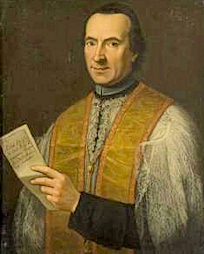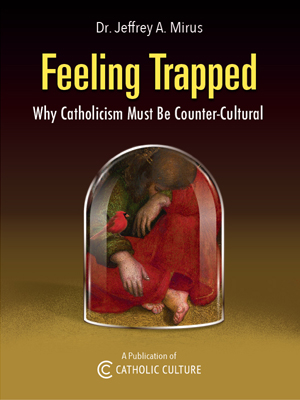Ordinary Time: May 23rd
Thursday of the Seventh Week in Ordinary Time
Other Commemorations: St. John Baptist de Rossi, Priest (RM)
» Enjoy our Liturgical Seasons series of e-books!
The Roman Martyrology commemorates St. John Baptist de Rossi (1698-1764), who was from Genoa, and studied and worked in Rome before becoming a priest there and a canon of Santa Maria in Cosmedin. He worked tirelessly for homeless women, the sick, prisoners and workers, and was a very popular confessor, being called a second Philip Neri.
On the first Thursday after Pentecost, the Feast of Our Lord Jesus Christ, the Eternal High Priest is observed on the particular calendars in Spain, Poland, Netherlands, Czech Republic and England and Wales. Approval for this feast was first granted by the Congregation for Divine Worship and the Discipline of the Sacraments in 1987. In 2012 the Congregation sent a letter to all conferences of bishops, offering the feast to be inscribed in their respective liturgical calendars if they ask for it.
Feast of Our Lord Jesus Christ, the Eternal High Priest
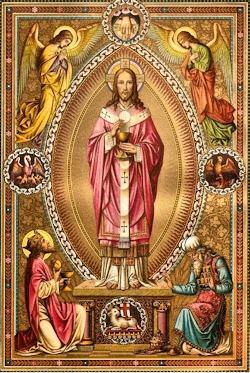 The feast focuses firstly on Jesus’ Priestly Office (Latin: Munus sacerdotale). He is considered the model for believers, and for the clergy in particular, with priests acting In persona Christi (“In the person of Christ”). The laity are thus urged to pray that priests would be more like Christ, the compassionate and trustworthy high priest (Hebrews 2:17), ever-living to intercede for humanity before The Father (Heb 7:25).
The feast focuses firstly on Jesus’ Priestly Office (Latin: Munus sacerdotale). He is considered the model for believers, and for the clergy in particular, with priests acting In persona Christi (“In the person of Christ”). The laity are thus urged to pray that priests would be more like Christ, the compassionate and trustworthy high priest (Hebrews 2:17), ever-living to intercede for humanity before The Father (Heb 7:25).
The Second Vatican Council taught many things about the Priesthood of Christ, and sharing in that one Priesthood through the Sacraments of Baptism and Holy Orders. This development has been reflected in many subsequent documents. One effective way to build upon this teaching is to establish the Feast of Christ the Priest more widely.
What Pope Pius XI wrote about the feast in honor of Christ’s Kingly Office can be said just as truly about this feast in honor of Our Lord’s Priesthood:
For people are instructed in the truths of faith, and brought to appreciate the inner joys of religion far more effectually by the annual celebration of our sacred mysteries than by any official pronouncement of the teaching of the Church. Such pronouncements usually reach only a few and the more learned among the faithful; feasts reach them all; the former speak but once, the latter speak every year - in fact, forever.[8]
The entry from the Roman Martyrology (2005) reads:
Thursday after Pentecost: The Feast of Our Lord Jesus Christ, The Eternal High Priest, according to the order of Melchizedek. In him the Father has been well pleased from before all time. As Mediator between God and human beings, fulfilling his Father’s will, he sacrificed himself once on the altar of the Cross as a saving Victim for the whole world. Thus, instituting the pattern of an everlasting sacrifice, with a brother’s kindness he chose, from among the children of Adam, men to augment the priesthood, so that, from the sacrifice continually renewed in the Church, streams of divine power might flow, whereby a new heaven and a new earth might be made, and throughout the whole universe there would be perfected what no eye has seen, nor ear heard, nor has entered into the human heart.
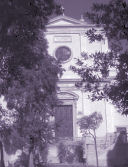
Thursday after Pentecost
Station with San Lorenzo in Panisperna (St. Lawrence in Panisperna):
Let us not forget that we celebrate today's mysteries "with St. Lawrence," the Roman deacon who walked so perfectly in the footprints of his predecessor in the diaconate, St. Philip. The unclean are cleaned, the sick are healed and joy reigns supreme. Pentecostal cleansing, pentecostal healing, pentecostal joy! Let us be modern Philips and Lawrences helping to alleviate bodily and spiritual misery of our brethren, thus paving the way for the "Spirit of the Lord who fillet the whole world." (Msgr. Martin Hellriegel)
The church stands on the site of St. Lawrence's martyrdom. The appellation refers to the name of the street, which in turn most likely refers to the tradition of the Poor Clares in the adjacent convent of distributing bread and ham (pane e perna) on August 10th, the feast day of St. Lawrence. This is done in remembrance of St. Lawrence distributing funds from the church to the poor.
For more on San Lorenzo in Panisperna, see:
For further information on the Station Churches, see The Stational Church.
St. John Baptist de Rossi
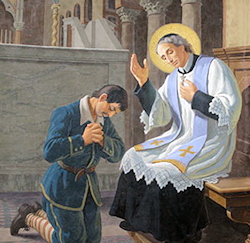
After three years he was called to Rome by a relative, Lorenzo de Rossi, who was canon at St. Mary in Cosmedin. He pursued his studies at the Collegium Romanum under the direction of the Jesuits, and soon became a model by his talents, application to study, and virtue. As a member of the Sodality of the Blessed Virgin and of the Ristretto of the Twelve Apostles established at the college, he led the members in the meetings and pious exercises, in visits to the sick in the hospitals and in other works of mercy, and merited even then the name of apostle.
At the age of sixteen he entered the clerical state. Owing to indiscreet practices of mortification he contracted spells of epilepsy, notwithstanding which he made his course of scholastic philosophy and theology, in the college of the Dominicans, and, with dispensation, was ordained priest on 8 March, 1721. Having reached the desired goal, he bound himself by vow to accept no ecclesiastical benefice unless commanded by obedience. He fulfilled the duties of the sacred ministry by devoting himself to the laborers, herds, and teamsters of the Campagna, preaching to them early in the morning, or late in the evening, at the old Forum Romanum (Campo Vaccino), and by visiting, instructing, and assisting the poor at the hospital of St. Galla. In 1731 he established near St. Galla another hospital as a home of refuge for the unfortunates who wander the city by night ("Rom. Brev.", tr. Bute, Summer, 573).
In 1735 he became titular canon at St. Mary in Cosmedin, and, on the death of Lorenzo two years later, obedience forced him to accept the canonry. The house belonging to it, however, he would not use, but employed the rent for good purposes.
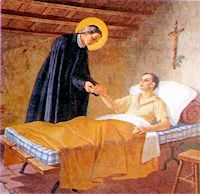 For a number of years John was afraid, on account of his sickness, to enter the confessional, and it was his custom to send to other priests the sinners whom he had brought to repentance by his instructions and sermons. In 1738 a dangerous sickness befell him, and to regain his health he went to Cività Castellana, a day's journey from Rome. The bishop of the place induced him to hear confessions, and after reviewing his moral theology he received the unusual faculty of hearing confessions in any of the churches of Rome. He showed extraordinary zeal in the exercise of this privilege and spent many hours every day in hearing the confessions of the illiterate and the poor whom he sought in the hospitals and in their homes. He preached to such five and six times a day in churches, chapels, convents, hospitals, barracks, and prison cells, so that he became the apostle of the abandoned, a second Philip Neri, a hunter of souls.
For a number of years John was afraid, on account of his sickness, to enter the confessional, and it was his custom to send to other priests the sinners whom he had brought to repentance by his instructions and sermons. In 1738 a dangerous sickness befell him, and to regain his health he went to Cività Castellana, a day's journey from Rome. The bishop of the place induced him to hear confessions, and after reviewing his moral theology he received the unusual faculty of hearing confessions in any of the churches of Rome. He showed extraordinary zeal in the exercise of this privilege and spent many hours every day in hearing the confessions of the illiterate and the poor whom he sought in the hospitals and in their homes. He preached to such five and six times a day in churches, chapels, convents, hospitals, barracks, and prison cells, so that he became the apostle of the abandoned, a second Philip Neri, a hunter of souls.
In 1763, worn out by such labors and continued ill-health, his strength began to ebb away, and after several attacks of paralysis he died at his quarters in Trinità de' Pellegrini. He was buried in that church under a marble slab at the altar of the Blessed Virgin. God honoured his servant by miracles, and only seventeen years after his death the process of beatification was begun, but the troubled state of Europe during the succeeding years prevented progress in the cause until it was resumed by Pius IX, who on 13 May, 1860, solemnly pronounced his beatification. As new signs still distinguished him, Leo XIII, on 8 December, 1881, enrolled him among the saints.
—Excerpted from The Catholic Encyclopedia
Patronage: of the abandoned
Highlights and Things to Do:
- Read the life of St. John Baptist de Rossi free at Google Books
- Read more about St. John Baptist de Rossi:
- His relics are located in Rome at the Church of San Giovanni Battista de Rossi.


